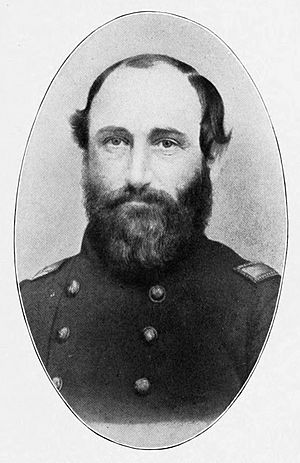James Redfield (Iowa soldier) facts for kids
James Redfield (born March 27, 1824 – died October 6, 1864) was an American leader who worked in government and served as an officer in the American Civil War. He sadly passed away during the Battle of Allatoona.
Contents
Early Life and Education
James Redfield was born on March 27, 1824, in a town called Clyde, New York. His father's name was Luther Redfield. James went to Yale College and finished his studies there in 1845.
After college, he decided to study law in his hometown. He was chosen to be the County School Commissioner, which meant he helped manage schools in the area. Later, he moved to Albany, New York, and worked for Christopher Morgan, who was the Secretary of State for New York at the time.
Moving to Iowa and Political Career
In 1855, James Redfield moved west to Iowa. He settled near the center of the state. A town there, Redfield, Iowa, was named after him.
He held several important jobs in Dallas County, Iowa. These jobs showed that people trusted him. In 1860, he was elected to the Iowa State Senate. This meant he helped make laws for the state of Iowa.
Service in the Civil War
When the American Civil War began, James Redfield quickly got involved. He helped create a group of soldiers and was chosen as their captain. When a larger group, called the 39th Iowa Volunteer Infantry Regiment, was formed, he became its lieutenant colonel. He stayed in this important role until his death.
His regiment fought in many battles in the western part of the country. They served under famous generals like Buel, Ulysses S. Grant, and William Tecumseh Sherman.
The Battle of Allatoona
In October 1864, a part of the Confederate army attacked a place called Allatoona Pass. Colonel Redfield was in the town of Rome, Georgia, at the time. He quickly led his soldiers to defend the pass.
During the intense fighting, Colonel Redfield was encouraging his men to keep fighting against the attack. Sadly, he was hit and died instantly. His body was buried in a small village near the battlefield. He left behind his wife and three children.
![]() This article incorporates public domain material from the Yale Obituary Record.
This article incorporates public domain material from the Yale Obituary Record.


